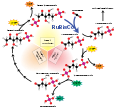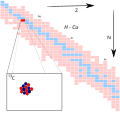C4 carbon fixation or the Hatch–Slack pathway is one of three known photosynthetic processes of carbon fixation in plants. It owes the names to the 1960s...
38 KB (4,488 words) - 23:16, 8 May 2024
C3 carbon fixation is the most common of three metabolic pathways for carbon fixation in photosynthesis, the other two being C4 and CAM. This process converts...
9 KB (1,063 words) - 05:23, 9 February 2024
In botany, C4 carbon fixation is one of three known methods of photosynthesis used by plants. C4 plants increase their photosynthetic efficiency by reducing...
28 KB (2,384 words) - 18:54, 26 June 2024
Calvin cycle (redirect from Carbon reaction)
available independent of the kind of photosynthesis (C3 carbon fixation, C4 carbon fixation, and crassulacean acid metabolism (CAM)); CAM plants store...
23 KB (2,772 words) - 15:08, 23 September 2024
Photosynthesis (redirect from History of C3 : C4 photosynthesis research)
three-carbon 3-phosphoglyceric acids directly in the Calvin-Benson cycle. Over 90% of plants use C3 carbon fixation, compared to 3% that use C4 carbon fixation;...
110 KB (11,776 words) - 21:08, 24 October 2024
Therapeutic Chemical Classification System C4 carbon fixation, a pathway for carbon fixation in photosynthesis that produces C4 plants Cervical spinal nerve 4, a...
7 KB (991 words) - 05:14, 11 October 2024
RuBisCO (section Alternative carbon fixation pathways)
light-independent (or "dark") part of photosynthesis, including the carbon fixation by which atmospheric carbon dioxide is converted by plants and other photosynthetic...
59 KB (6,522 words) - 18:16, 20 August 2024
Crassulacean acid metabolism, also known as CAM photosynthesis, is a carbon fixation pathway that evolved in some plants as an adaptation to arid conditions...
40 KB (3,838 words) - 20:55, 17 September 2024
Biological carbon fixation, or сarbon assimilation, is the process by which living organisms convert inorganic carbon (particularly carbon dioxide) to...
43 KB (3,852 words) - 14:24, 18 July 2024
compared to C3 plants with low water-use efficiency. C4 plants have developed the C4 carbon fixation pathway to conserve water loss, thus are more prevalent...
36 KB (4,271 words) - 20:26, 19 June 2024
12C is slightly higher in plants employing C4 carbon fixation than in plants employing C3 carbon fixation. Because the different isotope ratios for the...
9 KB (1,070 words) - 03:06, 25 July 2024
needed to sustain C3 carbon fixation photosynthesis used by trees. Some plants use the C4 carbon fixation method to persist at carbon dioxide concentrations...
98 KB (10,935 words) - 11:35, 29 October 2024
Vietnam. It is an extremely fast-growing tree, due to its use of C4 carbon fixation, and is planted for timber harvesting. It appears to be nowhere near...
2 KB (148 words) - 06:08, 10 January 2022
smaller number pointing downward. It includes five genera that use C4 carbon fixation: Chrysanthellum, Eryngiophyllum, Glossocardia (including Guerreroia)...
6 KB (462 words) - 14:31, 20 June 2024
Metabolism (section Carbon fixation)
photosynthesis occur in plants, C3 carbon fixation, C4 carbon fixation and CAM photosynthesis. These differ by the route that carbon dioxide takes to the Calvin...
113 KB (12,407 words) - 21:53, 31 October 2024
C4 carbon fixation, which represents about 3% of all terrestrial species of plants. All these 7600 species are angiosperms. C4 plants evolved carbon concentrating...
32 KB (3,704 words) - 22:06, 17 October 2024
portal Biological carbon fixation – Series of interconnected biochemical reactions Carbon dioxide scrubber – Device which absorbs carbon dioxide from circulated...
52 KB (5,674 words) - 13:10, 11 September 2024
Chloroplast (section Carbon fixation and G3P synthesis)
carbon dioxide concentrating mechanisms, or CCMs. These include Crassulacean acid metabolism, C4 carbon fixation, and pyrenoids. Chloroplasts in C4 plants...
189 KB (19,141 words) - 15:05, 28 October 2024
process of carbon fixation. Some of this biomass is eaten by animals, while some carbon is exhaled by animals as carbon dioxide. The carbon cycle is considerably...
95 KB (10,835 words) - 03:22, 27 July 2024
grandiflora is one of the few plants that is a C4/CAM intermediate, utilizing both C4 carbon fixation and Crassulacean acid metabolism pathways in different...
7 KB (715 words) - 20:02, 13 October 2024
Convergent evolution (section Carbon fixation)
independently up to 40 times. About 7,600 plant species of angiosperms use C4 carbon fixation, with many monocots including 46% of grasses such as maize and sugar...
57 KB (5,772 words) - 05:00, 12 September 2024
D-Malic acid (R) Malate plays an important role in biochemistry. In the C4 carbon fixation process, malate is a source of CO2 in the Calvin cycle. In the citric...
17 KB (1,322 words) - 04:54, 16 July 2024
northern Australia. At least four species in the genus have acquired the C4 carbon fixation pathway. Six species are accepted. Aerva javanica (Burm.f.) Juss....
4 KB (368 words) - 17:18, 11 April 2024
surrounding its use in carbon capture. Inaccurate citation practices have led to circulating claims that P. tomentosa performs C4 carbon fixation. However, this...
14 KB (1,355 words) - 03:08, 16 October 2024
southern North America. C4 carbon fixation evolved independently in the genera Alternathera, which also contains C3 and C3–C4 intermediate species, and...
7 KB (703 words) - 23:13, 20 December 2023
wood burial carbon sequestration run at 50 USD/tC which is much lower than carbon capture from e.g. power plant emissions. CO2 fixation into woody biomass...
119 KB (13,533 words) - 13:13, 16 October 2024
Isotopic signature (redirect from Carbon isotope ratio)
biochemical pathways; the C3 carbon fixation, where the isotope separation effect is more pronounced, C4 carbon fixation, where the heavier 13C is less...
41 KB (4,674 words) - 13:53, 28 June 2024
for his research that is attempting to replace C3 carbon fixation in rice with C4 carbon fixation. This would greatly increase the efficiency of photosynthesis...
14 KB (1,006 words) - 06:24, 15 October 2024
inorganic carbon concentrating mechanisms of C4 and CAM plants. The others are NADP-malic enzyme and NAD-malic enzyme. In C4 carbon fixation, carbon dioxide...
23 KB (2,733 words) - 19:04, 8 April 2024
to allow CO2 to enter, and close them during the day, or by using C4 carbon fixation. Many desert plants have reduced the size of their leaves or abandoned...
112 KB (13,062 words) - 03:10, 29 October 2024


























